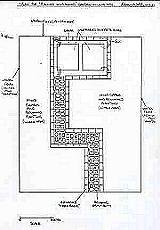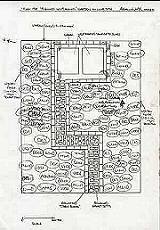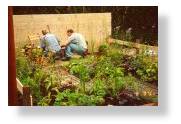|
|||
| I
am indebted to Jacqueline Attrill and Chris Wright, fellow finalists in
the "BBC Gardener Of The Year 2001" competition who generously
supplied the photographs for this article.
Jacqueline
provided photographs 1,3,6,7 and 8, and Chris provided photographs 2,4,
and 5. |
| The
Brief for Finalists
The final of the
"BBC Gardener Of The Year 2001" competition was scheduled to
take place at the Birmingham Botanical Gardens & Glasshouses between
Thursday August 30th and Sunday September 2nd 2001. |
| The
plots
Each plot was 4m x
5m. They were laid out in a circle so that the aspect was different for
each gardener, and plots were randomly allocated by the BBC. The soil
was neutral to slightly acidic, and was 20cm deep. Fortunately, my plot
was east facing. As it would get sun for most of the day, this did not
present many restrictions on the choice of plants. |
| My
Design : "Planned Unplanned"
After staring at a blank sheet of paper for three nights and doing some rough sketches (most of which were consigned to the waste paper bin) I realised two things. Firstly, as the plot was small, a formal design would probably work best. I also knew that this formal design could not be too elaborate as it might overpower the plot and the viewer. Secondly, as I am
interested in designs featuring naturalistic planting, (my "Planned
Unplanned" approach), I could take this one step further. Most schemes
featuring this style of planting (often referred to as "prairie planting")
have been created in large gardens. I decided to prove that not only can
this style of planting work in a small space, but that the effect is heightened
in a small space by contrasting this loose planting with a very formal
design of hard landscaping. |
| The
plants
The planting would mainly comprise grasses and herbaceous perennials, with bulbs for spring interest and a Daphne laureola for winter scent. I decided to use many plants which I had not yet used in my own garden. Rather than planting in groups of three or five, the plants would be scattered to create a random effect, almost as you would hope to find in a meadow. The planting would also have three tiers: tall grasses (Molinia "Transparent" and "Windspiel"); a middle layer of herbaceous perennials such as Echinops, Bronze Fennel and Verbena bonariensis and a lower layer of grasses (Deschampsia Tardiflora) and herbaceous perennials (e.g. Geranium "Brookside" and Nepeta "Walkers Low"). |
| The
written presentation
The brief which I presented to the BBC for 10th August is reproduced below. "Planned Unplanned" Adrian Walsh "The title of the garden is "Planned Unplanned". It is designed to demonstrate that a naturalistic planting can work even in a small formal space. The effect is achieved by using a variety of grasses and perennials to provide year round interest. Plants are allowed to self seed and move around the garden, only being curbed where they dominate or threaten to overpower another species. The garden is designed for anyone with an interest in a natural style of gardening. As plants mature and migrate, the fusion of planting forms will eventually exclude weeds, and will result in a maintenance-reduced garden. Plants will be left with seed heads intact to provide winter interest and to promote self-seeding. The soil will be left un-mulched to facilitate this. The hard landscaping in shades of blue-black and grey creates a formal effect and contrasts with the planting. Using reclaimed materials, it offers varied texture. The turn in the path forces the viewer to look at the garden from different perspectives going up to and down from the sitting area. In winter the hard landscaping will emerge from the melting perennial foliage and seed heads. The four box balls in pots will provide a "moveable feast", capable of being repositioned at any time of year to where they can be easily appreciated from inside or out. The evergreen Daphne Laureola, is planted near the house so that in darkest February, the sweet scent can be caught when outside on a damp still evening." |
|
 |
 |
| Building
the garden
Each finalist was allowed to bring along one helper to help build the garden. After much persuasion, I finally cajoled my oldest brother Brian to come along. As the finalists were away from the plots for up to three or four hours on both day two and three (to take part in the filming of "The Knowledge Challenge"), the helpers were left to get on with constructing the garden. Brian provided invaluable help in constructing the hard landscaping. Early on in the competition I was given the title "supervisor of the year" by Jacqueline, a finalist from York and Michelle her helper. Every time they popped over to see how things were progressing, I was having a rest or standing looking at Brian work. Unfortunately some of the photographs of us constructing the hard landscaping seem to bear this out... Each finalist had to submit a work plan to the BBC outlining the schedule of work which we would be undertaking over the four days. I aimed to get the posts in for the back fence and side fence on day one, lay the path on day two, erect the fence panels and commence the planting on day three, and complete the planting and finishing touches on day four. Work on the gardens normally started shortly after 8.00 a.m. and finished at 6.00 p.m. or 7.00 p.m.. While managing to complete the garden by 12.00 noon on the fourth day, the schedule of work did not always go to plan. |
| The
diary
Day 1 On the first day we did not actually start work on the gardens until after 11.00 a.m. due to delayed filming schedules as a result of showers and low light. Although Brian and I managed to get the posts in, hidden foundations from a previous garden which was on the site resulted in some of the posts being off-plumb when checked with a spirit level. We therefore had to take out some posts and dig out these old foundations to ensure the fence would be completely straight and plumb when the panels were put on. One post was taken out and replaced about four times (all caught on camera) until we were certain it was completely plumb. On day one we also chalked out the design for the path and sitting area and began digging out the foundations for the path. |
| Day
2
This was the first day on which finalists would be tested in "The Knowledge Challenge". Two of the knowledge rounds would be filmed which meant that finalists would be away from the plots for up to three or four hours. Having shown Brian the layout of the path and how the stable blocks and cobbles would be placed, he set to work to construct the hard landscaping, while I headed off to be quizzed. By the time I got back, he had almost completed the path to the design I had wanted. The quality of his work would subsequently be praised by the judges in the February 2002 edition of "Gardeners' World" magazine. In the afternoon, we laid the concrete slabs for the seating area and brushed a dry mix of sand and cement between the cobbles and stable blocks. This would hold the hard landscaping together and would set overnight, drawing moisture from the hard-core filling and earth below the path. Finally, we put up the panels of the back fence. The erection of the panels involved some precise work to ensure that levels were absolutely correct. Fortunately, the camera crew had gone home earlier than usual, as it turned out to be a job best done without the distraction of cameras watching our every move. |
|
|
2
|
3
|
| Day
3 The final two rounds of "The Knowledge Challenge" were filmed on this day. Brian got to work by filling the spaces between the cobbles with Mourne gravel. We also manoeuvred the sandstone sculpture into place and finished work on the single bar side fences. Although I had planned to commence the planting, I quickly realised how poor the soil was after digging over the plot. As a result we had to "riddle" the soil to get rid of a lot of stones and get ten wheelbarrow loads of fresh top soil. Afterwards, we dug in compost to further enrich the soil. The soil preparation took most of the afternoon to complete and this was an unexpected task. As a result, I only had time in the evening to position the pots of plants on the surface of the soil in preparation for planting on the fourth day. |
|
|
4
|
| Day
4
I arrived at the gardens at 7.00 a.m. on the Sunday morning, a full hour earlier than usual. I quickly set about planting, and did some fine tuning to the positioning of the plants. |
 |
Brian made out plant labels and constructed the small table for the seating area. |
|
6
|
| I did my final filmed interview with Diarmuid Gavin in the garden, and stepped out of the garden at 12.00 noon having just finished the final tasks of watering the plants, washing down the hard landscaping and positioning the chairs and table. The other finalists, having all finished earlier, were extremely helpful by getting large containers of water from which to fill the watering cans. | |
|
Judges Comments |
| Pippa Greenwood,
Gardeners' World, BBC TV
"I like the odd bit of "touchy feely" in amongst it all." "What's lovely is that it's quite low seating - it's like you're in amongst it." "Seeing this is Britain, there's an awful lot of stuff in here which looks really good when it's wet." Joe Swift, Gardeners' World, BBC TV "I like it actually, I do like it, it's very different." "It's quite an ambitious thing to do, trying to achieve that prairie planting, sort of naturalistic look in a small space, in a small garden, which is quite hard to achieve." Matthew Wilson, Curator, RHS Hyde Hall, Essex "The selection of plants is right for this style." "The depth element....you
can actually sit and look at this for a long, long time and find something
new all the time in the planting." |
|
Copyright
A Walsh 2002-2007
|